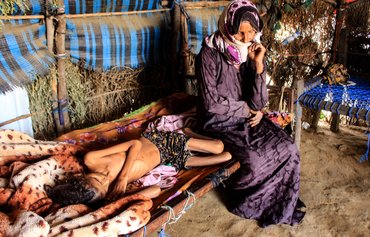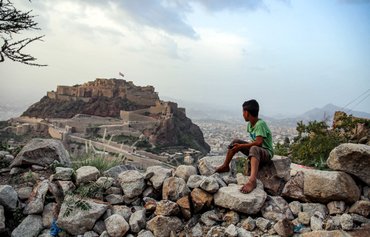ADEN -- Peace is the only solution to deteriorating humanitarian and economic conditions in Yemen, where the majority of the country's population is on the brink of starvation, local analysts say.
Famine is looming in Yemen amid the ongoing conflict, according to the Studies and Economic Media Centre (SEMC), a Yemen-based non-governmental organisation.
A full 80% of the population is now in need of aid, according to the United Nations (UN), amid a humanitarian crisis that erupted after the Iran-backed Houthis staged a coup in Sanaa in September 2014 and started a war.
In a July 28 report that studied the contrast in living standards between Houthi-controlled Sanaa and government-controlled Aden, the SEMC warned that "the conflict in its current form is leading the country to famine”.
![A boy sells jackets to pedestrians in Houthi-controlled Sanaa on March 24. [Mohammed Huwais/AFP]](/cnmi_am/images/2022/08/31/36794-Yemen-Sanaa-poverty-600_384.jpg)
A boy sells jackets to pedestrians in Houthi-controlled Sanaa on March 24. [Mohammed Huwais/AFP]
![Yemenis displaced by the conflict receive food aid and supplies to meet their basic needs at a camp in Hays district in al-Hodeidah province on March 29. [Khaled Ziad/AFP]](/cnmi_am/images/2022/08/31/36793-Yemen-food-aid-600_384.jpg)
Yemenis displaced by the conflict receive food aid and supplies to meet their basic needs at a camp in Hays district in al-Hodeidah province on March 29. [Khaled Ziad/AFP]
"The continuation of the military conflict and the fabrication of side economic battles have worsened the living conditions of citizens, who pay the price for any reciprocal measures between the two sides of the conflict in Yemen," the report said.
"The deficit of the monthly need for one family in the Houthi-controlled areas reached 85%, compared to 2% in the Yemeni government-controlled areas," it said. (State employees are paid regularly in areas controlled by the legitimate government.)
"There is a price difference of $21.80 between Houthi-controlled areas and Yemeni government areas for the monthly basic food basket, as a family in Sanaa needs $106.20 per month, while a similar family needs $84.40 per month in Aden [to survive]," the report said.
Costlier in Houthi-controlled areas
Field research for the SEMC report took place between January and April, said Mohammed Mahrous, one of the researchers who prepared the report.
This included comparing prices of basic commodities between the areas controlled by the Yemeni government, including Aden, and Houthi-controlled areas, including Sanaa, he said.
The comparison demonstrated the difference in the prices of essential goods between Sanaa and Aden, he said, and the team concluded it cost more to live in Houthi-controlled areas.
"Yemen has entered multiple economic crises as a result of the political and military divisions caused by the war," SEMC director Mustafa Nasr told Al-Mashareq.
"These divisions have negatively impacted lives and exacerbated the dire humanitarian and economic situation," he said.
They also spawned "a miserable living reality and led to the proliferation of poverty and its emergence in areas whose residents suffer from mass starvation", the SEMC report said.
Conditions were so dire that some residents of the northwestern province of Hajjah "were forced to eat tree leaves" to assuage their hunger, it said.
Millions face extreme hunger
According to the SEMC report, two out of three Yemenis -- 20 million men, women and children -- live in extreme poverty, and "millions face extreme hunger".
"Eight years of war and conflict have sapped the Yemenis' strength," economist Abdul Aziz Thabet told Al-Mashareq, adding that peace must prevail in order to prevent impending famine.
Unifying the political and economic decision-making processes and putting a stop to the free fall of the country's currency cannot be achieved unless the war stops, he said.
The war prompted Yemen's Central Bank to move from Sanaa to Aden in late 2016, after which state employees in Houthi-controlled areas stopped receiving their salaries, Thabet said.
The division of Yemen's Central Bank into two banks created two different economic approaches, he added.
The Houthis have refused to circulate new banknotes printed by the Aden-based bank, "causing the Yemeni riyal to lose at least a third of its value", said Thabet.
As of June, "while $1 equals about 1,100 [YER] in government-run territories, it is currently being exchanged for 557 [YER] in Houthi-held governorates", Al-Jazeera reported June 30.
International economic variables, especially Russia's invasion of Ukraine, have compounded the humanitarian crisis in Yemen, because they have raised the prices of basic food items, said Thabet.
Yemen suffered 30% inflation in 2021, the World Bank said in June.

![Hassan Razem, a 10-year-old child suffering from acute malnutrition, is pictured in Abs district, Hajjah province, on July 25. [Essa Ahmed/AFP]](/cnmi_am/images/2022/08/31/36792-Yemen-poverty-hunger-600_384.jpg)






